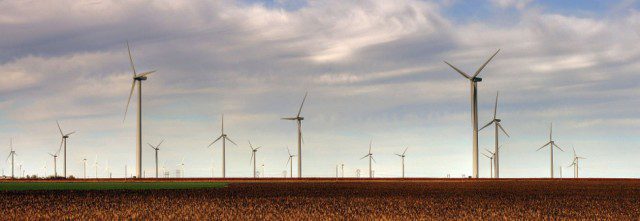
Utilities continue to invest in new surplus fossil fuel-fired generation capacity – primarily natural gas power plants in the U.S. – in order to compensate for the intermittent nature of wind and solar energy resources, co-lead author Christopher Clack, a CIRES physicist and mathematician, noted. That need not be the case going forward, however, he stated for a press release.
Fellow co-lead author Alexander MacDonald, who recently retired as director of NOAA’s Earth System Research Laboratory, pointed out that the sun is shining or the winds are blowing somewhere across the U.S. all the time. That suggests the issue of solar and wind energy intermittency may be resolved by scaling up renewable energy generation ¨to match the scale of weather systems.¨
Finding lowest-cost national energy mixes
Having studied weather and worked on improving forecasts for more than 40 years, MacDonald assembled a team of four other NOAA scientists to explore the idea of scaling up U.S. renewable energy generation to match the scale of weather systems. Making use of NOAA’s high-resolution meteorological data ¨they built a model to evaluate the cost of integrating different sources of electricity into a national energy system,¨ CIRES explains.
The team’s model estimates renewable energy resource potential, energy demand, CO2 emissions and the costs of scaling up and operating generation and transmission systems to meet future energy needs. This enabled them to assess the cost, reliability and greenhouse gas (GHG) emissions associated with various mixes of energy generation sources.
The researchers then programmed the model to seek out the lowest cost combination. No matter what constraints were applied, the model always wound up installing more renewable energy on the grid than exists today.
“Our research shows a transition to a reliable, low-carbon, electrical generation and transmission system can be accomplished with commercially available technology and within 15 years,” MacDonald highlighted.
A national superhighway for electrons
In seeking out lowest-cost solutions, the model incorporates costs related to building and paying for transmission infrastructure improvements – specifically a new, high-voltage direct-current transmission grid (HVDC) to supplement that in use today.

HVDC transmission lines are in use today, carrying electrical energy over long distances without losing nearly as much energy. The model chose to use newly installed HVDC lines extensively. Moreover, the research team concluded that investing in efficient, long-distance transmission was key to keeping costs low.
“With an ‘interstate for electrons’, renewable energy could be delivered anywhere in the country while emissions plummet,” MacDonald commented.
“An HVDC grid would create a national electricity market in which all types of generation, including low-carbon sources, compete on a cost basis. The surprise was how dominant wind and solar could be.”
The CIRES’ study has been published in Nature Climate Change. “This study pushes the envelope,¨ Stanford University’s Mark Jacobson wrote in commenting on the study in an editorial for the journal. ¨It shows that intermittent renewables plus transmission can eliminate most fossil-fuel electricity while matching power demand at lower cost than a fossil fuel-based grid – even before storage is considered.”
*Image credits: 1) The Smoky Hills Wind Farm in Kansas. Drenaline/Wikimedia Creative Commons; Cross Sound Cable


